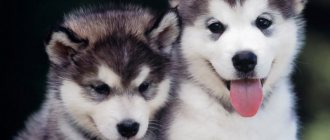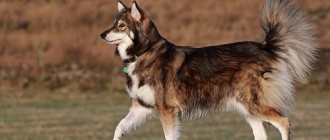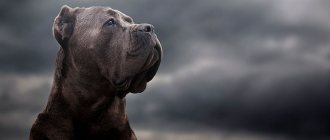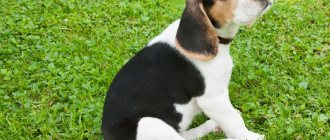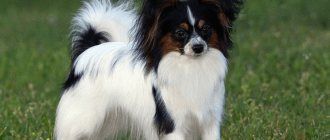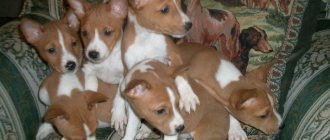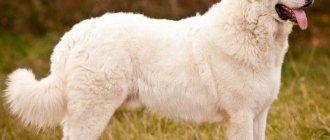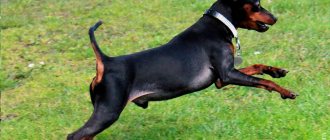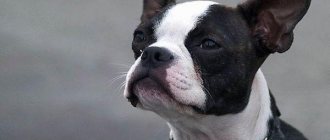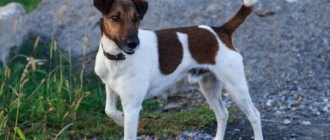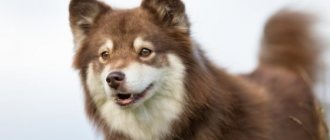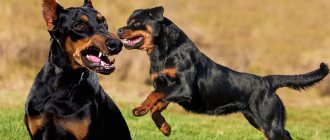Origin of the breed
Shikoku, or Kochi-inu, or Kochi-ken (ken means “dog” in Japanese), as well as Shikoku, Shikoku-igu, Koshi-ken, Mikawa-inu - a dog from the hunting group. Outwardly, it looks like a small wolf, which is not surprising, since it descended from wild dogs that lived on the island since ancient times. The breed is registered and protected by the Nippo organization.
Nihonken Hozonkai (Society for the Preservation of the Japanese Dog), abbreviated as Nippo, is an association of dog lovers in Japan. Engaged in the protection and popularization of Japanese breeds.
This organization of cynologists keeps records of the original, natural Japanese breeds, of which there are currently six:
- Akita;
- Hokkaido;
- kai;
- kisyu;
- Shikoku;
- Shiba.
This association has developed special standards for natural breeds in Japan, holds periodic exhibitions and has branches in many countries.
The homeland of the Shikoku breed is the island of the same name in Japan. Mentions of the Shikoku as a domesticated dog have been known since the Middle Ages. The Shikoku breed was bred primarily for hunting wild ungulates in the mountains of the island.
There were three types of Shikoku breed:
- Awa (ava);
- Hongawa (hongawa);
- Hata (hut).
These varieties are named after the area where they were bred. Among them, Hongawa is the most purebred, as it lived in inaccessible mountains, where mixing with other species is excluded. The dogs were hardy and agile. They had a peculiar sesame coat color. As a result, they received one common name based on the name of the entire region. In 1937, Shikoku was designated a Wildlife Refuge and is now highly valued and protected in Japan.
Shikoku is also recognized by the FCI association, which developed the world breed standard No. 319 dated 06/05/1995, and the Russian Cynological Federation (RKF).
FCI is an international organization of cynologists, based in Belgium, which registers new breeds.
The breed is also recognized by some local dog associations, for example, the North American Shikoku Club (NASC).
History of the breed
The homeland of this Japanese breed is the island of Shikoku , and it is from here that the breed got its name. Initially, the breed had another name - Tosa Inu, however, since fighting dogs also bore the same name, the name was eventually stopped being used. In the past, these dogs were very popular among Japanese hunters, since it was on the island of Shikoku that the main activity of the population was hunting, in particular wild boar.
The region where these dogs lived was characterized by mountainous terrain, which made it difficult to access, which limited the possibility of crossing Kochi-ken with other breeds. Such isolation led to the emergence of several breeding lines, which received names from geographical areas - Ava, Hata, Honkawa, they are distinguished by the highest purity of the breed and differ in the color of their sesame-colored coat.
Despite its enormous popularity in its homeland at the beginning of the 20th century, the breed was almost completely lost due to the hobby of breeders with European breeds, especially shepherd dogs. And only in the 30s. One of the famous Japanese dog handlers drew attention to this ancient breed, and he carried out a huge amount of work to restore the Shikoku. On his initiative, a monument was even erected to these dogs as a symbol of the country. Early 80s Shikoku were recognized by the International Canine Organization, and in the mid-90s. The breed standard was adopted.
Historical chronicles
In the circles of the Japanese cynological community, the theory of the origin of Shikoku from extinct island wolves has long been seriously and quite vigorously discussed.
“Water for the mill” is shed by the characteristic gloomy-predatory appearance and sternly unapproachable character of the dogs. The “Wolf version” is not subject to anything, but is not subject to absolute obstruction - the predatory family saga invigorates, awakens a romantic flair, and promotes PR activity. The only reliable and indisputable place of origin of medium-sized island huskies is the ancestral lands of the breed: the valleys and foothills of Kochi Prefecture, Shikoku Island (in ancient times - Tosa Province). The dogs were kept by hunters who hunted large animals: deer, boars, and small local bears. Island peasants also welcomed stocky dogs to their farmsteads to guard their property and work in the pasture.
In settlements isolated by mountains, three closely related branches of dogs were cultivated: Awa, Kogawa and Sanuki (from the names of the prefectures). Only in 1937 the “various variety” was raked out, a characteristic type was identified, and an independent species with a single standard and toponym was registered.
In 1982, the standard was approved by the FCI and included in the FCI register. In Russia, Shikoku-ken are represented minimally: there are no nurseries, there are no national breeding centers, single specimens are imported by enthusiastic collectors and fanatic fishermen.
Table: description of the Shikoku breed according to FCI standard No. 319
| Standard item | Description |
| Origin | Japan |
| Date of publication of the original current standard | 05.06.1995 |
| Usage | Hunting dog, companion dog |
| Classification FC I | Group 5 (Spitz and primitive breeds), section 5 (Asian Spitz and related breeds, without working tests) |
| General form | The dog is medium in size, proportionally built, with well-developed muscles. It has erect, pointed ears and a curled or crescent-shaped tail. The body is compact and strong, the bones are well developed |
| Important proportion | The ratio of the height at the withers to the length of the body is 10:11 |
| Behavior and character | The dog is very hardy, sensitive, has a direct character, very alert behavior, and is obedient to its owner. Gambling hunter |
| Head |
|
| Neck | Thick and powerful |
| Frame |
|
| Tail |
|
| Limbs | Forelegs:
The hind limbs are powerful, with well-developed muscles. The hock joints are very strong, the angle of the hock joints is moderate. Paws:
|
| Gait/movement | The movements are flexible, the step is rather short than wide, light. Movements are fast and nimble, with quick turns |
| Coat | Wool:
Color:
|
| Dimensions | Height at withers:
Permissible deviations + 3 cm |
| Disadvantages/defects | Any deviation from the above provisions should be considered a fault and the seriousness with which the fault should be assessed should be proportionate to its severity and its effect on the health and welfare of the dog. Flaws:
|
| Disqualifying faults |
|
| Special attention | Males must have two normally developed testes, fully descended into the scrotum. Only functionally and clinically healthy dogs with breed-specific characteristics can be used for breeding. |
Photo gallery: representatives of the Shikoku breed
The black sesame color has a lot of black hair.
The red sesame color looks like red with some black hair.
Shikoku are similar to wolves, which is due to their origin from wild dogs
Shikoku is very harmoniously built
Shikoku feels at home in the forests and mountains
Preparing for an exhibition is a responsible undertaking
Shikoku have powerful, muscular legs
Description and breed standard
Shikoku is a breed of dog with a Japanese appearance. They have a fluffy tail in the form of a ring, thrown over their back. The hair does not adhere tightly to the body, creating a feeling of plush fur.
The dogs have triangular, erect ears, slightly tilted forward, as well as expressive eyes and a special smile. The average body size of an adult Shikoku ranges from 42 to 55 centimeters in height and weighs from 20 to 25 kilograms.
The head is proportional to the body and has an elongated muzzle. A long neck, straight back, deep chest and tucked belly are the characteristic features of the breed.
The Shikoku's paws have powerful joints, with the help of which the dog confidently moves in small steps. By color there are sesame, black and red shades. Sesame is a base color with a hint of light tan.
Character and psyche
By nature, Shikoku dogs are enthusiastic, rather excitable animals. They combine organization and at the same time extreme energy - the qualities of a real hunter. Traits such as curiosity and extraordinary observation are also noted. Together with balance, these qualities help the dog to be a good watchman and protector.
Shikoku are distinguished by their loyalty. Left without an owner, the dog will no longer be able to accept a new owner.
In the breed's homeland of Japan, three characteristics are used to determine the individuality of a Shikoku:
- good character;
- active calm;
- openness.
Shikoku dogs are so-called natural dogs; they have aggression towards other animals in their blood. However, with good upbringing and socialization, Shikoku can get along well with other pets. It has been noted that Shikoku are very wary of strangers on their territory and may bite. They don't always get along with children. They allow only respectful treatment of their person and, in case of dissatisfaction, easily snap back, so such dogs are not suitable as a companion for small children. At the same time, Shikoku are good at obeying their owner, they try to stay close and, with good training, they always follow commands.
Video: keeping Shikoku outside the city
When I got to know the breed, I got the impression that we are talking about simple yard dogs. Looking at the dogs playing, a not very knowledgeable reader may think that two mongrels are playing. But upon closer examination and study, it is possible to identify the characteristics of the breed: a special muzzle, color, and build of the animals.
Breed characteristics
Size
Average
Need for activity
Lots of physical loads
Dominance
Moderate
Child Compatible
Only with older children
Difficult to care for
A little care
Guard qualities
Has skills, but guards poorly
Learning ability
Easy to learn
Independence
Relatively independent
Friendliness
Reserved
Noisiness
Rarely barks
Shedding level
Wool is everywhere
Contents in the apartment
Only if there is a physical
load It is worth keeping in mind that each dog is individual. This description is specific to the breed as a whole, so it may not match the description of your dog. How an animal will behave depends largely on its owner, and not on the breed. If you can't decide on a dog breed, we recommend that you use our online dog breed selection tool.
Features of care and maintenance
Shikoku are dogs adapted for outdoor living. In Japan, they are often kept in spacious enclosures and kennels. Shikoku can also live in city apartments provided they take long and constant walks, which are necessary to ensure good physical activity and relieve stress.
Problems with care may arise due to the fact that Shikoku sheds heavily. During the seasonal shedding season, the fur may fall out in clumps. Regular combing, once a week, with a special comb is required to minimize the problem.
Routine hygiene procedures should be followed, such as bathing every few months, trimming nails, and cleaning ears as needed.
Like other dog breeds, Shikokus need their teeth brushed. It is recommended to do it at home once a week or seek help from a veterinarian.
Shikoku diet
In the homeland of the Shikoku breed, they are fed both ready-made food and natural products, making up a balanced diet.
Breeders from other regions may encounter problems when choosing a natural diet. Shikoku dogs may not accept meats that are common, for example, to European breeds - beef, chicken. Since ancient times, in their homeland, Shikoku ate sea fish and seafood, seaweed, rice - everything that was in abundance on the island. The body of Japanese breed dogs is more adapted to digesting “light” protein. If you are the happy owner of a high-breed Japanese Shikoku, then natural food will not be cheap.
It is worth considering a diet using ready-made food to ensure that your pet is receiving a balanced diet. You will also know exactly what serving size is needed.
Recommendations for natural nutrition
It is recommended to feed an adult dog 2 times a day. The amount of food per meal is 400–500 grams.
For an adult Shikoku, the following diet can be recommended:
- sea fish and seafood;
- lean meat products;
- cereals;
- vegetables;
- fruits;
- dairy products.
Prohibited products:
- river fish (contains a lot of bones);
- smoked meats and sausages;
- pork and lard;
- dairy products with a high proportion of fat;
- corn;
- wheat and oats;
- sweets and other confectionery products;
- flour products, white bread;
- tubular bones;
- salty and spices;
- food with chemical additives.
Feeding recommendations
For Shikoku, it is better to use food based on rice, salmon or tuna. For some dogs of this breed, food containing lamb, rabbit, duck and rice will be quite suitable.
Acana Pacifica - dry grain-free dog food with fish
Manufacturers offer two types of feed:
- dry;
- wet.
Wet ones have the advantage of not making dogs thirsty, having a soft structure and containing less concentration of chemical additives.
It is better to give preference to one type of food; alternating and mixing one with another can cause stomach problems for your pet.
Advantages of ready-made feeds:
- no need to waste time preparing food for your pet;
- no additional feeding with vitamins is required;
- The possibility of infection by parasites and poisoning by stale products is excluded.
One of the disadvantages is the fact that some types of feed may contain preservatives and other harmful substances, but in expensive products this is practically excluded.
Care
The hard and thick coat of the Shikoku does not require special care. It is enough to comb the dog once a week with combs of different heights and lengths of teeth. In general, Shikoku fur tends to self-clean, so it is recommended to bathe the dog no more than once every two to three months. But rapidly growing claws need to be trimmed as needed, and you also need to take care of the hygiene of your ears and teeth.
Training
Due to the difficult nature of the Shikoku, it is better for experienced dog breeders who also have the opportunity to keep a dog outside the city to get such a dog. As already mentioned, long walks are important for these dogs; they need to run at least 6 kilometers a day to maintain physical and mental fitness.
When raising these dogs, it is important to prevent them from becoming dominant in the home. The first thing a Shikoku must learn is to respect its owner.
It is better not to use physical violence. Since Shikoku have a high level of intelligence, training should be based on the animal’s interest in following commands. It is better to carry out the training process in the form of a game, so the dog will be better able to grasp new commands and carry them out with more pleasure than under duress.
Socialization is a very important aspect of training. It is important that the dog communicates with people and is not afraid of them; this will help avoid unnecessary aggression and raise a confident animal. If the dog is planned to be used as a hunting dog, then the puppy should be taken out into the forest from an early age.
Shikoku are recognized by the FCI federation and participate in exhibitions
Character
The character of the Akita Inu is almost completely free of negative qualities. With a stretch, this includes insatiable curiosity. Dogs must know about every little thing that happens (or appears in the apartment). The pet will constantly “get underfoot”, will be the first to check any bags brought, and will react to the slightest movement. Akita Inu puppies are very cheerful, playful, love to play mischief, but do not show aggression. Psychologically, they mature quite late (closer to two years).
Gradually the character of dogs changes. With age, restraint, calmness, and the dignity of a true aristocrat appear in him. At first glance, it seems that the Akita Inu is self-sufficient and does not need society - this is a mistaken opinion. Behind the mask of equanimity is hidden a very gentle, impressionable creature who requires the love and affection of those around her.
Akita Inu likes to carry objects in its teeth. They will be happy to bring slippers or a leash before a walk. They can grab you by the wrist or pull - this way the dog does not attack, but demands attention to itself.
There are some cat habits in the behavior of dogs. For example, they love to lick their fur. The manner of attack is also different: the “Japanese” track down a potential enemy, crouching to the ground, choosing the right moment, silently rushing at the prey. They do not bark often, but they make a wide variety of sounds, reminiscent of snorting, grunting, moaning and others.
Dogs adore all family members, but only as long as they are treated with respect.
It is important to remember that Japanese dogs are extremely touchy and rarely forgive a bad attitude or rudeness towards themselves. Kindness will be responded to with unquestioning obedience and meekness.
Animals are absolutely not prone to mischief. They will not chew shoes or damage furniture in the house.
Choosing a Shikoku puppy and price
There are very few dogs of the Shikoku breed in the world, there are few of them even in their homeland in Japan. The popularity of the breed is not growing yet. Perhaps this is due to the presence in countries of their own so-called natural breeds (huskies, Samoyeds). But there are still lovers and connoisseurs of the breed.
There are Shikoku nurseries in Europe, one of them is based in Estonia, and there is also a nursery in the Netherlands. If you wish, you can find a purebred Shikoku puppy in Russia. In Russia these are nurseries:
- "Demishstar" in Vladivostok (headed by Zhanna Demisheva);
- FUDZISAN in Saratov (founder Julia Tarkhanova).
If you want to buy a Shikoku puppy, you should contact one of the breed clubs. It is impossible to choose a purebred puppy yourself if you are an amateur dog breeder. Alternatively, you can buy a puppy in Japan. True, in this case you need to be prepared for a lot of effort and money.
The cost of a baby Shikoku on the market in Japan is 250 thousand yen, which is approximately 8 thousand dollars.
The first Shikoku puppies in the FUDZISAN kennel were born in 2018
